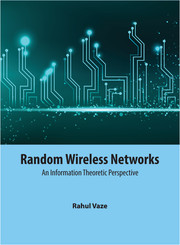Book contents
- Frontmatter
- Dedication
- Contents
- List of Figures
- Preface
- Acknowledgments
- Notation
- 1 Introduction
- 2 Transmission Capacity of ad hoc Networks
- 3 Multiple Antennas
- 4 Two-Way Networks
- 5 Performance Analysis of Cellular Networks
- 6 Delay Normalized Transmission Capacity
- 7 Percolation Theory
- 8 Percolation and Connectivity in Wireless Networks
- 9 Throughput Capacity
- Index
- References
2 - Transmission Capacity of ad hoc Networks
Published online by Cambridge University Press: 05 May 2015
- Frontmatter
- Dedication
- Contents
- List of Figures
- Preface
- Acknowledgments
- Notation
- 1 Introduction
- 2 Transmission Capacity of ad hoc Networks
- 3 Multiple Antennas
- 4 Two-Way Networks
- 5 Performance Analysis of Cellular Networks
- 6 Delay Normalized Transmission Capacity
- 7 Percolation Theory
- 8 Percolation and Connectivity in Wireless Networks
- 9 Throughput Capacity
- Index
- References
Summary
Introduction
In the first part of this book, starting with this chapter, we focus on the single-hop model for wireless networks, where each source has a destination at a fixed distance from it and each source transmits information directly to its destination without the help of any other node in the network.
For the single-hop model, in this chapter, we begin by introducing the concept of transmission capacity of wireless networks, which measures the largest number of simultaneously allowed transmissions across space, satisfying a per-user outage probability constraint. To facilitate the analysis of transmission capacity, we assume that the nodes of the wireless network are distributed ‘uniformly randomly’ in space as a Poisson point process (PPP). We first describe some tools/results from stochastic geometry that are necessary for the transmission capacity analysis with PPP-distributed nodes.
Using these tools/results from stochastic geometry, we then present an exact characterization of the transmission capacity of a wireless network under the Rayleigh fading model, when each node has a single antenna and uses an ALOHA protocol. The derived results reveal the dependence of several important parameters on the transmission capacity, such as outage probability constraint, path-loss exponent, rate of transmission per node, and ALOHA transmission probability. Using the exact expression for the transmission capacity, we find the optimal transmission probability for the ALOHA protocol that maximizes the transmission capacity. For the path-loss model, where the effects of multi-path fading are ignored, we also present a lower and upper bound on the transmission capacity that are tight in the parameters of interest. The technique used in finding the lower and upper bound has wider ramifications for cases where exact expressions on the transmission capacity cannot be found.
We then present a surprising result that even when each node transmits independently using an ALOHA protocol in a wireless network with PPP-distributed node locations, the interference received from all nodes at any point in space has spatial as well as temporal correlation. The inherent-shared randomness arising out of PPP distribution on the location of nodes gives rise to this correlation.
Information
- Type
- Chapter
- Information
- Random Wireless NetworksAn Information Theoretic Perspective, pp. 12 - 42Publisher: Cambridge University PressPrint publication year: 2015
